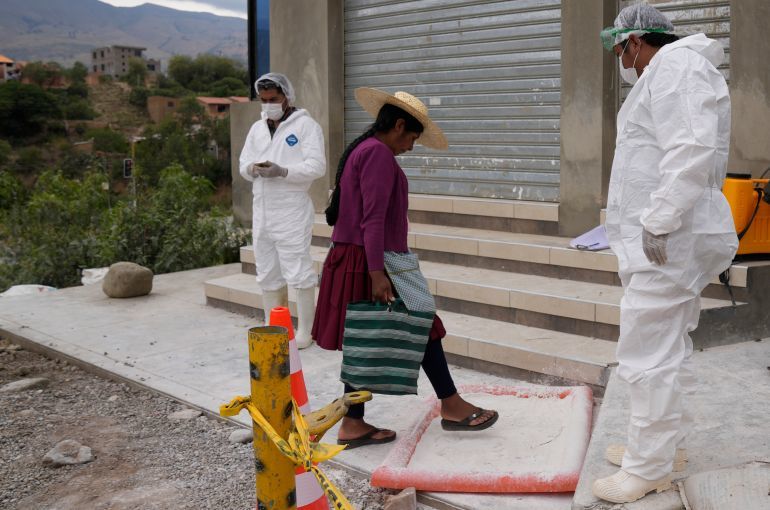
Will bird flu spark the next pandemic?
It is a bloody trail: Avian flu has killed 15 million domestic birds and led to the culling of an unprecedented 193 million more since October 2021. The rampant virus has jumped from Europe and Asia to North America — spreading shortly afterwards to bird populations in South and Central America.
And it is no longer restricted to birds. In the United States, the list of wild mammals either killed by or culled over avian influenza outbreaks is growing: grizzly bears in Nebraska and Montana, a red fox in Montana, six skunks and raccoons in Oregon, a Kodiak bear in Alaska and more.
Then in January, the World Health Organization (WHO) reported avian influenza in a young girl in Ecuador, the first such case ever in Latin America.
The story of these outbreaks is playing out like the opening shots of a pandemic movie — with the scene-stealer from last October in Galicia, Spain. There, week by week, the mortality rate in a mink farm of 50,000 animals rose. Coming soon after another outbreak on the coast near Coruña, which left 27 seabirds sick or dead, avian influenza became a suspect. But sequencing revealed something more sinister: a mutation that had enabled the first-ever large-scale case of direct mammal-to-mammal transmission of bird flu.
There have only been five human bird flu cases in the last year. But past human cases of H5N1 avian influenza have had a 53 percent mortality, according to the WHO.
With the virus driving poultry shortages, killing droves of wild birds, and increasingly spilling over to mammals, the situation begs an overarching question: Could avian influenza evolve from an ecological disaster to a full-blown pandemic?
The short answer: For the moment, the risk of consistent bird flu transmissions to — and between — humans is low, according to scientists. But the fast-proliferating avian influenza infection is becoming a contender virus that could drive the next pandemic, one with a mortality rate that, if it spreads among humans, could make COVID-19 seem mild in comparison.
 A woman steps on lime, set up by health workers who created a sanitation
perimeter near chicken farms, as she walks home amid a health alert due
to a bird flu outbreak in Sacaba, Bolivia, Tuesday, January 31, 2023
A woman steps on lime, set up by health workers who created a sanitation
perimeter near chicken farms, as she walks home amid a health alert due
to a bird flu outbreak in Sacaba, Bolivia, Tuesday, January 31, 2023
The mafia takes over
Avian influenza is actually a catch-all term for several strains of flu. The strain typically of concern is H5N1, each letter-number pair classifying the types of bonding proteins the virus has on the surface. But to truly understand H5N1 and contextualise its recent proliferation, one has to rewind to the late 1990s in China.
Speaking to Al Jazeera, Isabella Monne, a researcher with Italy’s Istituto Zooprofilattico Sperimentale delle Venezie who recently studied the mink outbreak in Galicia, noted that in 1996, H5N1 emerged in Chinese poultry production. The dense quarters and high populations favoured the emergence of more virulent strains, which jumped to wild bird populations in 2005.
This enabled the virus to spread further around Asia, Europe and the Middle East. Between 2003 and 2009, 468 human cases, primarily among poultry workers, resulted in 282 deaths. All the way through 2020, the number of host species and populations expanded exponentially. In all, the virus has killed 457 people in the last 20 years.
Then, in 2021, a front-running clade, or family, of H5N1 variants executed a mafia-esque takeover. By the end of 2021, the 2.3.4.4b clade was not only behind the vast majority of new cases in Europe, Asia, and the Middle East — but had also jumped to Canada and the US. In 2022, the clan made its move to Central and South America, as well.
With the rise in outbreaks among poultry and wild birds, the increase in mammalian infections is not surprising, Kaitlin Sawatzki, a molecular virologist and animal surveillance coordinator with Tufts University, told Al Jazeera, describing the cases of spillover to mammals as individual incidents.
In birds, said Sawatzki, H5N1 is primarily a gastrointestinal infection that spreads through faeces.
In order to infect humans, said William Schaffner, a professor of medicine at Vanderbilt University’s Division of Infectious Diseases, the virus has to attach to receptors in the lungs — receptors it lacks the ability to readily bond with. This forced adaptation to replicating in the lungs is why only poultry workers, who breathe in contaminated faecal dust, are typically infected. It is also why there had never been any large-scale cases of mammal-to-mammal transmission.
Until Galicia.
 Workers near a dead seal lying on the shore of the Caspian sea in the
Russian republic of Dagestan on May 5, 2021. In January 2023, a spike in
deaths of seals in Dagestan triggered concerns over possible causes
Workers near a dead seal lying on the shore of the Caspian sea in the
Russian republic of Dagestan on May 5, 2021. In January 2023, a spike in
deaths of seals in Dagestan triggered concerns over possible causes
Minks, seals … humans?
According to Monne, following outbreaks of H5N1 in local bird populations, the Galician minks were most likely infected by contact with wild birds. As Monne herself helped uncover, the virus, in the dense population of mammalian hosts, developed a mutation in a gene called PB2.
While it is too early to know how much this contributed to the virus’ jump to minks, the PB2 mutation is known to increase the activity of an enzyme involved in viral replication in mammalian cells. This same mutation was also found in the strain of H1N1 swine flu that caused the 2009 pandemic, killing between 123,000 and 203,000 people worldwide.
“The mutation is a signal that this virus is trying to cross the barrier between species and adapt to the mammalian population,” Wenqing Zhang, the head of the World Health Organization (WHO) global influenza programme, told Al Jazeera.
Sawatzki believes the mink case is not necessarily an example of sustained transmission. The PB2 mutation was concerning but did not enable the virus to jump to humans or other species. It was a dead end. No workers were infected. The minks were culled. The viral genome was sequenced and closely monitored.
More concerning for her is last year’s mass mortality of harbour seals off the US coast of Maine, as well as the more recent deaths of 2,500 seals off the coast of Dagestan, Russia. Seals, she said, do not consume or get exposed to birds in quantities that would explain their high infection rates.
The implication: While it has yet to be confirmed, the seals may have an as-of-yet unidentified, alternative route of infection in a wild population that cannot be as easily monitored or culled.
 A sign warning against entry to a white turkey farm is seen as part of
an effort to prevent exposure to avian influenza on November 14, 2022,
in Townsend, Delaware, the US
A sign warning against entry to a white turkey farm is seen as part of
an effort to prevent exposure to avian influenza on November 14, 2022,
in Townsend, Delaware, the US
No immunity
What does all of this mean for human health?
There are two potential ways humans can get an H5N1 respiratory infection: from animals or through person-to-person spread. The latter has only been suspected in an exceedingly small and largely unconfirmed handful of cases — the most recent being from 10 years ago.
Furthermore, many of the recent bird flu headlines have been a story of successful monitoring. According to Zhang, the WHO has been tracking influenza outbreaks and viruses for more than 70 years. The organisation actively sequences variants that arise worldwide, tracking mutations of concern as they arise — a capability that has only improved since the COVID-19 pandemic.
In the event of an outbreak, the WHO’s Pandemic Influenza Preparedness Framework mandates that a portion of any vaccines manufactured be donated to the organisation. Likewise, stockpiles of existing antivirals would likely be relatively effective against an outbreak.
The threat of an H5N1 pandemic is not currently high. However, sooner or later, “there will be another influenza pandemic,” said Zhang. If the culprit of that pandemic is avian influenza, the consequences could be heavy.
The flip side of H5N1 viruses rarely infecting humans is the complete lack of immunity to the virus, Zhang said. So if the virus did evolve a way to reliably transmit from animals to humans, or worse yet, between humans, it would almost certainly mean a pandemic.
And there is a readily available mechanism for that evolution.
Influenza viruses have an eight-segment genome. Each segment can potentially swap genes with other influenza viruses inside a host, a process known as reassortment. This, Schaffner told Al Jazeera, makes minks and swine — which can contract human, swine, and avian influenza viruses — potential mixing bowls.
In, say, a pig simultaneously infected with a human-associated flu virus and avian influenza, this genetic reshuffling could result in a deadly new virus: one with H5N1’s virulence and mortality, and the receptors to precisely target humans.
 Partially empty shelves with eggs are seen at a grocery store Tuesday,
January 10, 2023, in Orlando, Florida. The bird flu outbreak, combined
with soaring feed, fuel and labour costs, has driven up egg prices
significantly
Partially empty shelves with eggs are seen at a grocery store Tuesday,
January 10, 2023, in Orlando, Florida. The bird flu outbreak, combined
with soaring feed, fuel and labour costs, has driven up egg prices
significantly
Already a crisis
Developing an entirely new vaccine would likely take six to seven months, said Schaffner. Existing stockpiles of antivirals, he said, would likely be consumed quickly. Thus, if the bird flu sweeping the world does lead to a pandemic among humans, it would probably fall on lockdown procedures to buy time for a vaccine.
“COVID has told us about the effects of behavioural interventions,” said Schaffner. During lockdowns, “while we were social distancing and all wearing masks, we had a season with almost no influenza”.
In the wake of COVID-19, people are practised at distancing procedures. Granted, another lockdown might be a hard sell to a weary public. Nevertheless, given the high mortality of historical H5N1 cases, Schaffner believes that once casualties start rising, people would likely toe the line — slowing the spread of a potential avian influenza outbreak.
To be sure, there is only a slight risk of avian influenza targeting humans at the moment, but that comfort belies three concerning certainties. There will be an influenza emergency at some point; there are simply too many types of influenza, which mutate easily, and for which humans have limited resistance. Bird flu is a growing contender for the pandemic prize, threatening a mortality rate that far eclipses that of COVID-19. And in some ways, H5N1 is already a pandemic.
It is a pandemic on the beaches of Peru, where more than 10,000 pelicans have washed ashore in recent months. It is a pandemic in the empty nests of seabird colonies the world over. It is a pandemic for those who rely on both the money and food provided by poultry production, who had to cull millions of animals in the past 15 months.
Nutritionally, economically and ecologically, H5N1 is already a crisis. And despite the current low risks, the high-stakes threat of a bird flu pandemic among humans has the world at attention.











